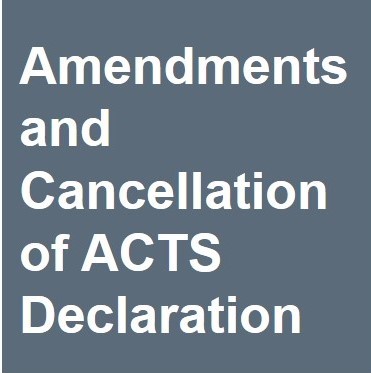Registration and ACTS Declaration
Step 1: Register as ACTS Trader
You are required to be registered as an ACTS trader with Singapore Customs and be provided with a user account in ACTS before you can submit a declaration in ACTS.
You will need to complete the following application forms:
Upon registration, Singapore Customs will issue a Trader Identification Number (TIN) to the registered ACTS trader (also known as Principal) and a Personal ID to each registered employee(s) for the submission of declarations in ACTS. A Principal can also authorise a different legal entity to submit the ACTS declaration on their behalf by submitting a Broker/Declarant Authorisation Letter. Both the employee of the Principal Trader and the representative/broker authorised by the Principal Trader can submit the declaration in ACTS.
Step 2: Obtain a Guarantee
Before the commencement of a transit journey, ACTS traders are required to lodge a single journey or multiple journey guarantee in the country of departure where the goods are loaded:
- Single Journey Guarantee covers only a single transit operation by the Principal concerned, covering the full amount of duties, taxes and other charges for which the goods are liable.
- Multiple Journey Guarantee covers several transit operations up to a given Reference Amount, set to equal 100% of the total amount of duties and other charges that may be incurred for goods under the Principal’s transit operations over a period of at least one week.
For the issuance of the Guarantee Undertaking Letter for transit operations, we accept all banks and finance companies as long as they are registered with the Monetary Authority of Singapore . For more information, please refer to: security lodgement.
You may obtain the relevant forms from the ACTS webpage here and submit the completed Forms to the participating banks for lodgement of guarantee.
Step 3: Apply for Customs Permit
Existing domestic customs procedures continue to apply to the movement of goods into and out of Singapore under ACTS. Please refer to the Quick Guide for Importers and Exporters to know more about the import and export procedures.
You are therefore required to apply for a customs permit via TradeNet to account for the importation, exportation and transhipment of goods in addition to submitting a declaration through ACTS. In the TradeNet permit application, you should indicate “ACTS Movement” in the Trader’s Remark field. The normal controls and requirements for TradeNet permit applications e.g. proper authorisation/licences from the Competent Authorities (CA) will continue to apply.
Step 4: Make an ACTS Declaration through ACTS
Registered traders must submit a declaration in the ACTS to initiate a transit movement.
What type of goods are allowed to be moved under the ACTS?
Under ACTS, a list of prohibited, excluded and restricted list of goods is maintained by each ASEAN Member State based on respective security and safety requirements. As long as goods declared in your ACTS declaration is prohibited and excluded in any of ASEAN Member States involved in the transit movement, the product will not be allowed to be moved under the ACTS.
Dutiable goods in Singapore are not allowed to be moved under the ACTS. You are advised to check with the respective Customs administrations of the other ASEAN Member States on the relevant requirements.
How do I declare an outgoing ACTS movement from Singapore?
If you are exporting goods as a non-ATT under normal procedures, you will need to plan and indicate your preferred journey route. For goods departing from Singapore, you may select either Woodlands Checkpoint or Tuas Checkpoint as the Office of Departure. The truck will need to be physically presented at the selected Office of Departure. The Office of Transit and Office of Destination to be selected will be located in other countries, depending on the route.
If you are exporting goods as an ATT under simplified procedures, you may select either Woodlands Checkpoint or Tuas Checkpoint as the Office of Departure and Office of Transit. If you select Woodlands as Office of Departure, it should also be reflected as Office of Transit. The same applies to Tuas Checkpoint.
| Non-ATT (Normal Procedures) | ATT (Simplified Procedures) | |
|---|---|---|
| Office of Departure | Tuas or Woodlands Checkpoint | Tuas or Woodlands Checkpoint |
| Office of Transit | Customs office in other country(ies) e.g. Malaysia | Tuas or Woodlands Checkpoint and Customs office in other country(ies) e.g. Malaysia |
| Office of Destination | Customs office in other country e.g. Thailand | Customs office in other country e.g. Thailand |
Upon the approval of your ACTS declaration, you will be issued with the Transit Accompanying Document (TAD), which is a single transit barcoded document. Please print a copy of the TAD and pass it to the truck driver for cargo clearance at the land checkpoints.
How do I declare an incoming ACTS movement into Singapore?
If you are importing goods as both a non-ATT or ATT, the overseas trader based in the country of departure should select either Woodlands Checkpoint or Tuas Checkpoint as the Office of Destination in the ACTS declaration.
You may refer to the Procedures Manual for Principals and Transporters for more information.
Step 5: Prepare Documents for Cargo Clearance
All incoming and outgoing ACTS trucks are to be physically present at the land checkpoints for clearance. The truck driver will need to present the physical copy of TAD, corresponding customs permit and supporting documents for cargo clearance. Please note that existing domestic clearance procedures would still apply.
 |
 |
 |
 |
 |

